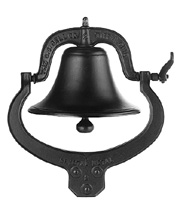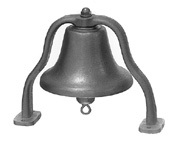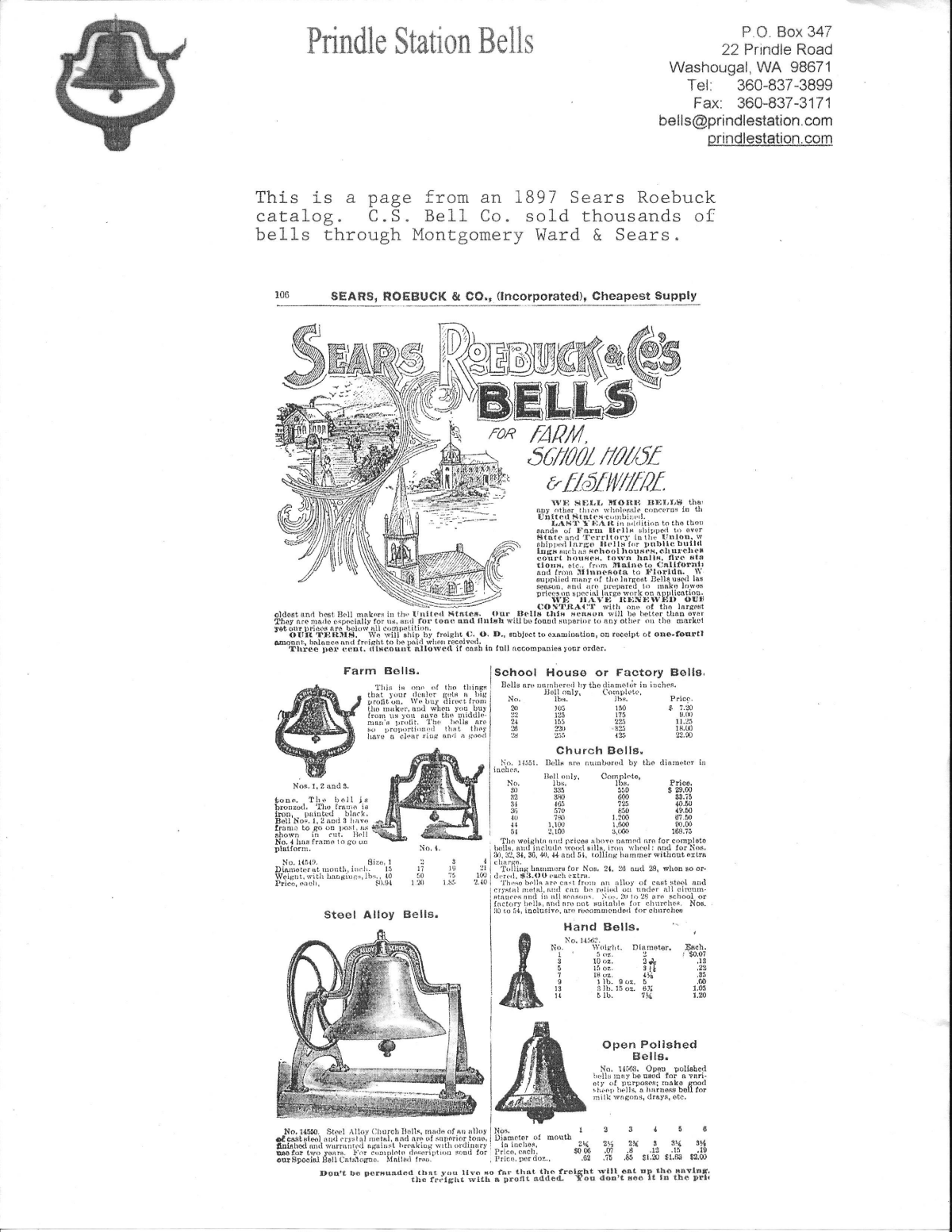The Bell Foundry
Bells were invented in 400 A.D. by Bishop Paulinus of Compagnia. They were not used in churches until some two hundred years later. A bell is described in the dictionary as “a hollow cup-shaped instrument that gives forth a clear, resonant note when struck with a clapper.” The world has been greatly benefited by the melodious tones of the bells manufactured originally by the C. S. Bell Company of Hillsboro, in Highland County. Today, those original patterns are used by Prindle Station to manufacture historical C.S. Bell Company bells for customers around the world.

Charles S. Bell, native of Cumberland, Maryland, was apprenticed to the founder’s trade in Pittsburgh, Pennsylvania, at the age of fifteen. After mastering the details of the trade, he eventually arrived in Hillsboro, a stranger with very little capital. He commenced the foundry business on a small scale, principally, in the manufacture of cooking stoves of superior quality. By making a good reputation he soon found his business growing. The need for larger quarters became imperative.
In January 1858, Bell purchased the Speedwell Foundry on W. Beech, being operated by Bitler and Clayton. He started work with one boy and a weekly expense of $7.00. In addition to stoves they began to make plow points and other castings.
In a few years a second foundry and showroom were built on the northwest corner of Main and West Streets. James K. Marlay became a partner and was placed in the showroom, while Bell operated the foundry. The following advertisement appeared in the newspaper when the new store opened:
BELL AND MARLAY
IRON FOUNDERS AND MACHINSTS
Cane Mills, evaporators, and sugar mill, C.S. Bells patent
Steam generators, plows and other agricultural machinery.
When making of sorghum syrup sprang up in the North, Bell designed a cane mill to meet the demand. The mill was very efficient, simple to operate, strong, cheap and very durable. It was equally well adapted to the southern sugar cane, being grown on the small plantations.
Bell advertised for sale: “A cast center lever plow, 100 bells, made from the best materials at the foundry.” The also had on hand a number of improved beehives and were prepared to pay cash for any amount of scrap iron.
In 1869 Bell purchased Marlay’s interest and continued to add various items to those he already sold and manufactured.
The pioneer Bell had a natural aptitude for metallurgy and continued to experiment with different formulas of iron, steel and other metals in his search to find an alloy cheaper and more durable than iron. Bell continued his experiments and his business continued to expand. One day he was busily engaged in the foundry working with a metal formula he had developed when he accidentally dropped a piece. To his great surprise he heard a ringing tone that “sounded like a bell.” He experimented, mixed ingredients, poured them carefully, and cooled them just so, until he had a metal with bell tones. The alloy or “peculiar amalgam” developed by Bell could be produced cheaper than brass, copper or tin, which were being used in the manufacture of bells. Bell also discovered that the alloy from which he made the bells could be pitched, with very mellow tone.
He began to manufacture other machinery in his shop, which included “Mogul” stoves, coffee pulpers, grinders, burr and hammer type food and feed grinding mills, cane and maple syrup evaporators and plows. He also made a “tortilla” used in Mexico to grind hominy from which “to make a popular hominy cake.” This particular grinder was painted a brick red and was in great demand until the color of paint was changed to green. Sales on the grinder fell to such a low point that a representative was sent to Mexico to find out the reason. The Mexicans vowed that the “green tortillas” were inferior and would not wear well. Needless to say, Bell changed the color back to red and regained the business.
The first year after the discovery of the bell formula, 1,000 bells were sold. The bells were made in different sizes, suited to farms, factories, taverns, schoolhouses, churches, etc. The greatest demand at that time was for the smallest size, which were especially adapted for farm use. They drove out the old tinhorn whose ear-piercing “tan-ta-ra-ra” was wont to call the farm folks from the fields to dinner, or on other occasions. In 1875 over 5,000 bells were sold and more than 700 mills, as well as other items. He employed some 30 hands during most of the year, who earned better than average wages.

C.S.Bell Company
In 1889 over 20,000 bells were
manufactured and sold. They were sent
out by horse-drawn wagons, by ship and by rail to all parts of the civilized
world. Charles E. Bell, son of the
founder, was taken into partnership in 1882 and the C.S. Bell Co. was formed. The son became a world traveler and built up
outlets in many foreign countries.
Orders poured in from South Africa,
Brazil and Central
America for cane mills and evaporators. Rice mills were shipped to China feed and grinding mills, corn
shellers, stoves and other items were shipped to all points of the compass.
By 1892 over 100 men were employed
in the various departments in the new plant erected on a seven-acre tract of
land at the edge of town. With the new
facilities the C.S. Bell Co. produced 2,000 tons of bells, 400 tons of cane
mills and 400 tons of other manufactured items per year. The company with its increased business was
incorporated in 1894.
Charles S. Bell died in 1905. Charles E. Bell and Co continued the
business. The sale of the bells was
slow, so the company again concentrated on the manufacture of laborsaving
machinery for the farm. About 1,000
bells per year were produced. The
members of the C.S. Bell Co. in 1912 were Charles E. Bell, president; Libby
Boyd, vice president; Ernest W. Shumacher, treasurer; and Blair M. Boyd,
secretary.
Virginia Bell, daughter of Charles
E. Bell, obtained a good education, traveled extensively in Europe and spent
some time in New York City. When her father died in 1929 the foundry was
taken over by relatives. The business of
the factory began a steady decline. Miss
Bell gave up a theatrical career to return to Hillsboro.
She gradually brought order out of chaos in her grandfather’s beloved
bell foundry. The company was
re-organized in 1934 with the following officers: Joseph M Gaites, president;
Loyd E. Shirley and Charles “Chuck”, son of Charles E. Bell, vice presidents;
and Virginia Bell, secretary, treasurer and general manager.
The defense armament in pre-World
War II days caused a shortage of metal, especially brass and copper used in
most bells made by government contract.
Virginia Bell learned that the Bureau of Ships was looking for a metal
bell to substitute for the regulation bells.
She personally obtained a contract from the Navy Department to furnish
them certain types of bells.
The Bell Foundry began producing
bells by the thousands. They were made
for all classes of ships in the U.S. Navy, for the British Navy with “H.M.S.”
on them and also for the Russian Navy.
Dignitaries of the allied Navies arrived in Hillsboro to visit the largest bell foundry
in the world. Flags were flown and many
state and town officials were on hand as a reception committee to welcome both
British and high-ranking Russian officers.
Many references were made to the
“Old Bell of ‘76” and how vividly the patriotic pen has pictured its sacred
associations. How they had described the
old sexton, leaning from the bell tower
of Independence Hall,
anxiously waiting the signal from below that a new nation had been born:
“High in the belfry the old sexton
stands,
Grasping the rope in his thin, bony
hands.
Fixed in his gaze, as by some magic
spell,
Till he hears the distant murmur,
“Ring the Bell!”
In 1959 over 100 years after Charles Bell opened the small
foundry on Beech Street,
the C.S. Bell Co. moved into an ultra-modern steel-fabricated concrete block
plant. The streamlined new foundry whose
products are sold in a worldwide market is located near the railroad at the
western edge of Hillsboro. It is still considered a true example of
American free enterprise. Virginia Bell
(Mrs. John Thompson) managed
the plant successfully from 1934 to 1969 when the factory
was sold. When the new building was
planned, they took into consideration railroad loading facilities, acreage for
an airplane landing field with a motor outlet on U.S. 50.
Bell’s Foundry is one of
the largest factories of its kind in the World today. From a small beginning in Hillsboro where his wife “baked” the early
cores in the oven of their home, Charles Singleton Bell made his name
synonymous with bells wherever one chooses to travel. Bell’s
bells ring out their gleeful tiding or their mournful tremors around the
world. The magnificent and melodious
bells from Hillsboro
have rung out their delightful tunes for over a century. Kindly their tones will continue to mingle
with our thoughts and our future for many years to come, for the bells produced
were “strong, sturdy, and very durable.”
We, at Prindle Station, hope you have enjoyed
this history of our bells. We are
pleased to manufacture the C.S. Bell bells and hope you enjoy your bell for
generations to come.

|